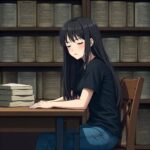Reader’s Question:
I just finished watching the second season of the anime “Kusuriya no Hitorigoto.” Is there a continuation in the manga? I saw that a sequel for the anime has been announced. If there is more in the manga, which volume should I start from to continue reading?
Introduction
Anime has
become a multifaceted form of entertainment that transcends borders, cultures, and art forms. One such example is “Kusuriya no Hitorigoto,” a show that has captivated audiences with its intricate storytelling and character development. It is not merely a display of animated visuals but rather a canvas for exploring complex psychological themes and societal issues. This piece aims to analyze the continuation of “Kusuriya no Hitorigoto” in both its manga and original novel forms while delving into the psychological underpinnings of its characters and the ethical considerations within the anime industry.
Background Context
“Kusuriya no Hitorigoto,” also known as “The Apothecary Diaries,” is based on a light novel series written by Natsu Hyuuga. The narrative intricately weaves the life of Maomao, a young apothecary with a sharp intellect and a keen understanding of herbs and their medicinal properties. The anime adaptation has garnered significant attention, leading to discussions about future installments and the original source material from which it draws. As noted in the user’s comments, the anime adaptation has covered the first four volumes of the original light novel series, with the sequel expected to dive into the fifth volume. For those wishing to continue their journey in the manga, there are two adaptations: one serialized in “Sunday GX” and another in “Big Gangan.” The “Sunday” version has already progressed to encompass much of the fifth volume, while the “Big Gangan” version lags behind, illustrating the complexities involved in adapting literature into visual media.
Industry Analysis
The anime industry has evolved into a colossal enterprise, generating billions in revenue annually. The adaptation of light novels into anime has become a prevalent trend, and while it provides much-needed visibility and accessibility to original works, it also raises ethical questions about fidelity to source material and the implications for original authors. From a legal standpoint, adaptations must navigate copyright issues, licensing agreements, and potential disputes over creative control. For instance, in the case of “Kusuriya no Hitorigoto,” the anime’s success relies on the original work’s intellectual property rights. The announcement of a sequel indicates both confidence in the narrative’s potential and the necessity to respect the original author’s creative vision. In terms of audience engagement, the balance between adhering to the original story and appealing to a broader viewer base is a tightrope walk for creators. Audiences often develop strong attachments to characters and narratives, making it imperative for adaptation teams to respect core themes while enhancing visual storytelling.
Character Psychology
At the heart of “Kusuriya no Hitorigoto” lies the richly developed character of Maomao. Her personality is a fascinating amalgamation of intellect, curiosity, and a hint of social awkwardness. Understanding her character from a psychological perspective reveals layers of complexity. Maomao’s background as a woman in a patriarchal society and her role as an apothecary reflect the internal and external conflicts faced by individuals in a system that often undervalues their contributions. This dual struggle embodies what psychologists recognize as the “double bind,” where individuals are constrained by societal expectations yet yearn for personal agency. From a developmental psychology viewpoint, Maomao’s character exhibits traits aligned with Erikson’s stages of psychosocial development, particularly the stage of identity versus role confusion. As she navigates her world, her actions demonstrate an active quest for self-discovery and autonomy. This resonates deeply with viewers, particularly young adults grappling with their identities. Moreover, the dynamics Maomao shares with other characters can be analyzed through the lens of attachment theory. Her interactions reflect various attachment styles—secure, anxious, and avoidant—shaping her relationships with peers and mentors alike. This nuanced character development invites viewers to reflect on their interpersonal relationships and the psychological frameworks that influence them.
Storytelling Ethics
Ethical considerations in storytelling are paramount, especially concerning how narratives portray social issues and character development. In “Kusuriya no Hitorigoto,” themes such as gender roles, societal expectations, and individual agency come to the forefront. The ethical implications of representing these themes can be dissected through the lens of social responsibility in media. Creators have a duty to present narratives that foster understanding and empathy while challenging existing stereotypes. The portrayal of Maomao as a female protagonist who defies conventional roles is a step toward inclusive storytelling, offering an inspiring figure for audiences. However, ethical concerns also arise regarding how these themes are interpreted by different cultural audiences. The global popularity of anime necessitates a more thoughtful approach to cultural sensitivity. Adapting stories for a broader audience should not lead to the dilution of their core messages. Instead, creators should strive for authenticity that resonates across cultural lines, sustaining the integrity of the original work.
Cultural Impact
Anime is not merely entertainment; it is a cultural phenomenon that influences and reflects societal values. The global reach of series like “Kusuriya no Hitorigoto” speaks volumes about the power of storytelling in bridging cultural divides. As anime continues to gain traction worldwide, it becomes critical to recognize its potential for cultural exchange. The depiction of characters like Maomao offers a glimpse into Japanese societal norms and historical contexts, allowing international audiences to engage with themes of resilience and self-determination. Such narratives can inspire discussions on gender equality, mental health, and the importance of individual agency, fostering a more nuanced understanding of different cultures. As viewers engage with these stories, they often reflect on their societal norms and values, leading to personal and collective growth. For creators, understanding the cultural significance of their work can enhance its impact, making it not just a product of entertainment but a catalyst for positive change.
Actionable Advice for Fans and Creators
For fans eager to dive deeper into the world of “Kusuriya no Hitorigoto,” here are some practical tips: 1. Read Beyond the Anime: Explore the original light novels and manga adaptations to gain a well-rounded understanding of the story and characters. Engaging with different formats allows for a richer experience and a deeper appreciation of the narrative’s intricacies. 2. Engage with the Community: Join online forums or local anime clubs to discuss episodes, themes, and character developments. Engaging with fellow fans can offer new perspectives and insights, enriching your viewing experience. 3. Analyze Character Motivations: Take time to reflect on characters’ motivations and the psychological factors influencing their actions. This exercise can enhance your understanding of human behavior and societal norms. For creators, consider the following: 1. Prioritize Ethical Storytelling: Strive for authenticity and cultural sensitivity in your narratives. Aim to challenge stereotypes and present multifaceted characters that resonate with diverse audiences. 2. Embrace Collaborative Efforts: Work with individuals from various backgrounds to ensure a more inclusive representation in your storytelling. Diverse perspectives can elevate the quality and impact of your work. 3. Stay Informed about Psychological Insights: Understanding psychological principles can aid in character development and narrative pacing. Familiarize yourself with theories such as attachment, identity development, and social dynamics to craft compelling stories.
Conclusion
As we anticipate the continuation of “Kusuriya no Hitorigoto,” both in anime and its original literary forms, it is essential to appreciate the intricate tapestry woven through its characters and narratives. The blend of psychological depth, ethical storytelling, and cultural significance offers a rich field for exploration, reflection, and discussion. Whether you are a fan eagerly awaiting the next installment or a creator inspired to contribute to this vibrant medium, the lessons learned from “Kusuriya no Hitorigoto” can serve as guiding principles. The world of anime is a testament to the power of storytelling to illuminate, educate, and inspire—an opportunity for all of us to engage, reflect, and grow. I invite you to share your experiences and thoughts on the series. How has “Kusuriya no Hitorigoto” impacted your understanding of character psychology or societal issues? Let’s continue the conversation!



